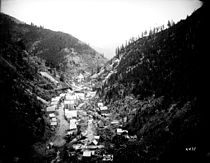Burke, Idaho
| Burke, Idaho | |
|---|---|
| Ghost town | |

Burke in 1888
|
|
| Coordinates: 47°31′13″N 115°49′13″W / 47.52028°N 115.82028°WCoordinates: 47°31′13″N 115°49′13″W / 47.52028°N 115.82028°W | |
| Country | United States |
| State | Idaho |
| County | Shoshone |
| Elevation | 3,700 ft (1,100 m) |
| Time zone | Pacific (PST) (UTC-8) |
| • Summer (DST) | PDT (UTC-7) |
| ZIP code | 83807 |
| Area code(s) | 208 |
Burke is a ghost town in Shoshone County, Idaho, United States. Once a thriving silver, lead and zinc mining community, it is far smaller now than at its height. In 2002, about 300 people lived in or nearby in the lengthy and narrow Burke-Canyon, about 300 feet (90 m) in width. In its early years, Burke was home to the Hercules silver mine, the owners of which were implicated in the Idaho mining wars of 1899. Burke was also the location of the Hecla and Star mines. After years of decline, Burke mining operations finally ceased in 1981 with the closing of the Star mine; which reopened for a short period in the 1990s.
In recent years, Hecla Mining Company has been exploring the potential of exploiting additional resource deposits in the Star mine. As of December 31, 2012, Hecla invested $7 million in rehabilitation and exploration with published estimates suggesting the potential to recover in excess of 25 million ounces of silver from the site with significant zinc and lead deposits also present.
Burke is located about 7 miles (11 km) northeast of Wallace, at an elevation of 3,700 feet (1,130 m) above sea level. It is accessed from Wallace on Burke-Canyon Creek Road (State Highway 4).
Hard rock miners in Shoshone County protested wage cuts with a strike in 1892. Two large mines, the Gem mine and the Frisco mine in Burke-Canyon 1 mile south of Burke, operated with replacement workers during the strike. Several lost their lives in a shooting war provoked by the discovery of a company spy named Charles A. Siringo The U.S. Army forced an end to the strike.
...
Wikipedia


